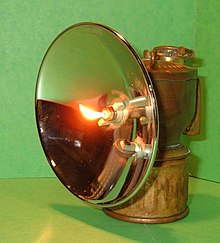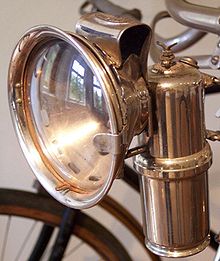| Revision as of 15:52, 25 February 2013 editAddbot (talk | contribs)Bots2,838,809 editsm Bot: Migrating 15 interwiki links, now provided by Wikidata on d:q606683 (Report Errors)← Previous edit | Revision as of 00:58, 9 March 2013 edit undoMorgan Riley (talk | contribs)Extended confirmed users12,247 edits →External links: added navboxNext edit → | ||
| Line 75: | Line 75: | ||
| {{Artificial light sources}} | {{Artificial light sources}} | ||
| {{Mining equipment}} | |||
| ] | ] | ||
| ] | ] | ||
Revision as of 00:58, 9 March 2013



Carbide lamps, or acetylene gas lamps, are simple lamps that produce and burn acetylene (C2H2) which is created by the reaction of calcium carbide (CaC2) with water.
Acetylene gas lamps were used to illuminate buildings, as lighthouse beacons, and as headlights on motor-cars and bicycles. Portable carbide lamps, worn on the hat or carried by hand, were widely used in mining in the early twentieth century. They are still employed by cavers, hunters, and cataphiles.
Mechanism
The conventional process of producing acetylene in a lamp involves putting the calcium carbide in the lower chamber (the generator). The upper reservoir is then filled with water. A threaded valve or other mechanism is used to control the rate at which the water is allowed to drip into the chamber containing the calcium carbide. By controlling the rate of water flow, the production of acetylene gas is controlled. This, in turn, controls the flow rate of the gas and the size of the flame at the burner, (and thus the amount of light it produces).
This type of lamp generally has a reflector behind the flame to help project the light forward. An acetylene gas powered lamp produces a surprisingly bright, broad light. Many cavers prefer this type of unfocused light as it improves peripheral vision in the complete dark. The reaction of carbide with water produces a fair amount of heat independent of the flame. In cold caves, carbide lamp users can use this heat to help stave off hypothermia.
When all of the carbide in a lamp has been reacted, the carbide chamber contains a wet paste of slaked lime (calcium hydroxide). This is emptied into a waste bag and the chamber can be refilled.
Small carbide lamps called "carbide candles" are used for blackening rifle sights to reduce glare. These "candles" are used due to the sooty flame produced by acetylene.
Use in caving
Early caving enthusiasts, not yet having the advantage of light-weight electrical illumination, introduced the carbide lamp to their hobby. While increasingly replaced by more modern choices, a substantial percentage of cavers still use this method.
In cave surveys, carbide lamps are favoured for the lead or "point" surveyor, who must identify suitable points in the cave to designate as survey stations. The sooty carbide flame may be used to harmlessly mark cave walls with a nontoxic and removable station label. Especially favoured for this purpose are all-brass lamps or lamps made with no ferromagnetic metals, as these lamps do not deflect the needles of a magnetic compass, which is typically read while brightly illuminated from above using the caver's lamp.
Apart from their use as cave surveying tools, many cavers favour carbide lamps for their durability and quality of illumination. They were once favoured for their relative illumination per mass of fuel compared to battery powered devices, but this advantage was largely negated with the advent of high-intensity LED illumination.
The acetylene producing reaction is exothermic, which means that the lamp's reactor vessel will become quite warm to the touch; this can be used to warm the hands. The heat from the flame can also be used to warm the body by allowing the exhaust gases to flow under a shirt pulled out from the body: such a configuration is referred to as a "Palmer furnace", after geologist Arthur Palmer.
Other uses
Acetylene lamps were also used on riverboats for night navigation. The National Museum of Australia has a lamp made in about 1910 that was used on board PS Enterprise, a paddle steamer which has been restored to working order and is also in the museum's collection.
They are also used for night hunting in some African countries.
History
In 1892, Thomas Willson discovered an economically efficient process for creating calcium carbide, which is used in the production of acetylene gas. In 1895, he sold his patent to Union Carbide. Domestic lighting with acetylene gas was introduced circa 1894 and bicycle lamps from 1896.
The first carbide mining lamp developed in the United States was patented in New York on August 28, 1900 by Frederick Baldwin. Another early lamp design is shown in a patent from Duluth, Minnesota on October 21, 1902. In the early 1900s, Gustaf Dalén invented the Dalén light. This combined two of Dalén's previous inventions: the substrate Agamassan and the Sun valve. Inventions and improvements to carbide lamps continued for decades. On March 10, 1925 Andrew Prader of Spokane, Washington was granted a United States Patent, number 1,528,848 for certain new and useful improvements for Acetylene Lamps.
After carbide lamps were implicated in an Illinois coal-seam methane gas explosion that killed 54 miners, the 1932 Moweaqua Coal Mine disaster, carbide lamps were less used in United States coal mines. They continued in use in the coal pits of other countries, notably Russia and Ukraine.
In the birth of the cinema of Iquitos, a carbide lamp was used as light support to project the first film in the Casa de Fierro, in 1900.
See also

Notes
- Caving equipment and culture (from Te Ara Encyclopedia of New Zealand)
- Paddle Steamer Enterprise, National Museum of Australia
- U.S. patent 656,874
- U.S. patent 711,871
- Patent number 1528848
References
- Clemmer, Gregg. American Miners' Carbide Lamps: A Collectors Guide to American Carbide Mine Lighting. Westernlore Publications, 1987.
- Thorpe, David. "Carbide Light: the Last Flame in American Mines." Bergamot Books, 2006. ISBN 0-9760905-2-X
- Thorpe, David. "Beneath the Surface: Inventors and Marketeers of the Miners' Carbide Light." Bergamot Books, 2010. ISBN 0-9760905-6-2
- Pohs, Henry. "The Miners Flame Light Book" Flame Publishing, 1995. ISBN 0-9641165-0-2
- Card, Peter W. (2004). Early Vehicle Lighting. Shire Publications. ISBN 978-0-7478-0585-4.
{{cite book}}: Unknown parameter|month=ignored (help)
External links
- acethylene.com A comprehensive guide to the care and maintenance of acetylene gas lamps
- A User's Guide to Carbide Cap Lamps. Has many good pictures & videos.
- Carbide lamp Demonstration experiment: Instruction and video
- The Carbide Caver A website on the history, restoration, and use of carbide lamps for caving.
| Lighting | |||||||||||||
|---|---|---|---|---|---|---|---|---|---|---|---|---|---|
| Concepts | |||||||||||||
| Methods of generation |
| ||||||||||||
| Stationary | |||||||||||||
| Portable | |||||||||||||
| Automotive | |||||||||||||
| |||||||||||||
| |||||||||||||
| |||||||||||||
| Related topics | |||||||||||||
| Mining equipment | |||||||||
|---|---|---|---|---|---|---|---|---|---|
| Excavation |
| ||||||||
| Transport |
| ||||||||
| Safety | |||||||||